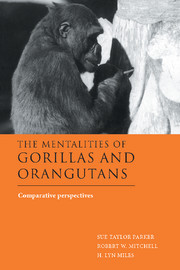Book contents
- Frontmatter
- Contents
- List of contributors
- Preface
- Acknowledgments
- I Comparative evolutionary and developmental perspectives on gorillas and orangutans
- II Cognition and tool use in gorillas and orangutans
- 4 Intelligent tool use in wild Sumatran orangutans
- 5 Orangutans' imitation of tool use: a cognitive interpretation
- 6 Object manipulation and skill organization in the complex food preparation of mountain gorillas
- 7 Development of sensorimotor intelligence in infant gorillas: the manipulation of objects in problem-solving and exploration
- 8 Tool use in captive gorillas
- 9 A survey of tool use in zoo gorillas
- III Communication in gorillas and orangutans
- IV Social cognition in gorillas and orangutans
- V Epilogue
- Index of authors
- Index of subjects
6 - Object manipulation and skill organization in the complex food preparation of mountain gorillas
Published online by Cambridge University Press: 20 October 2009
- Frontmatter
- Contents
- List of contributors
- Preface
- Acknowledgments
- I Comparative evolutionary and developmental perspectives on gorillas and orangutans
- II Cognition and tool use in gorillas and orangutans
- 4 Intelligent tool use in wild Sumatran orangutans
- 5 Orangutans' imitation of tool use: a cognitive interpretation
- 6 Object manipulation and skill organization in the complex food preparation of mountain gorillas
- 7 Development of sensorimotor intelligence in infant gorillas: the manipulation of objects in problem-solving and exploration
- 8 Tool use in captive gorillas
- 9 A survey of tool use in zoo gorillas
- III Communication in gorillas and orangutans
- IV Social cognition in gorillas and orangutans
- V Epilogue
- Index of authors
- Index of subjects
Summary
NATURAL HISTORY
In his monograph on the mountain gorilla of the Virunga Volcanoes, Schaller describes how gorillas eat over thirty different foods (Schaller, 1963, pp. 156–165). The accounts are brief, and sometimes based on only a very few observations. Nevertheless, it is immediately clear to the reader that interestingly different techniques are involved with each plant.
Some, such as the vine Droquetia iners, are “merely pushed into the mouth.” Almost as little care is taken with small ferns Polypodium sp.: to eat them a gorilla “reaches below the branch and without looking grabs a handful of the hanging ferns which it pulls in. After severing and discarding the roots with one bite, it stuffs the greens into its mouth.” Biting off encasing material is a method used in several different ways to detach inedible, contaminated, or, occasionally edible parts. Bark from the tree fern Cyathea deckenii is bitten off and discarded in small piles, and only the tender inside is eaten; taproots of the herbs Cynoglossum amplifolium and C.geometricum are hauled out of the ground and their tough bark is bitten off before consumption; in contrast, the dry bark of Hagenia and Hypericum trees is bitten off, but consumed.
Other plants evidently present more challenge to preparation. Often, this is a consequence of the relatively greater hardness and toughness of the encasing material compared with the fragile but edible interior. Schaller noted that feeding remains of bamboo Arundinaria alpine suggest that the tough and hairy outer layers are “peeled back to expose the pith, much as a human prepares a banana.”
- Type
- Chapter
- Information
- The Mentalities of Gorillas and OrangutansComparative Perspectives, pp. 147 - 159Publisher: Cambridge University PressPrint publication year: 1999
- 10
- Cited by



